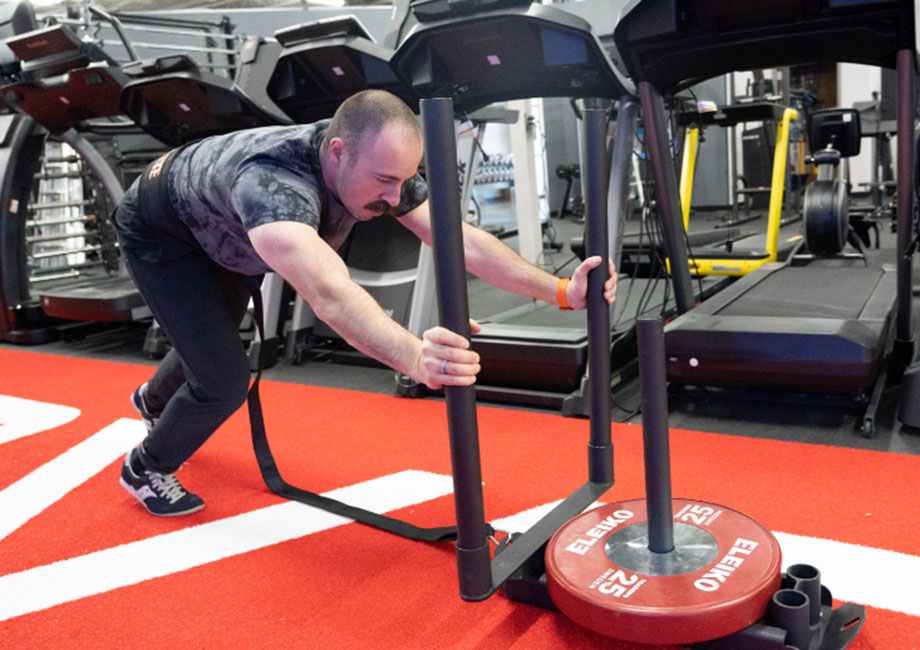We test and review fitness products based on an independent, multi-point methodology. If you use our links to purchase something, we may earn a commission. Read our disclosures.
You may have seen people perform a sled push or sled pull workout and then collapse. The sled is referred to as a prowler sled, which is why this phenomenon is called the “prowler flu”—nausea, vomiting, body aches, and/or upper-respiratory distress—when someone has hit their limit. If you have witnessed this or experienced it firsthand, then you have seen the true power of what pushing fitness boundaries is all about.
RELATED: Best Weight Sleds
That said, it doesn’t alway have to be that gut-emptying. The sled push workout is a simple but effective addition to strength and conditioning workouts. You load it and push the sled for a specified distance, feeling the burn in your lungs and legs. The sled is a fantastic full-body exercise for improving cardiovascular endurance and mental toughness and adding muscle mass to the posterior chain and quads. You can also build up your stamina by taking it slow at first to prevent the dreaded flu.
Here, we’ll get into all things sled push workout for your lung-burning pleasure.
How To Sled Push
- Load the sled and stand facing it at arm’s length.
- Grip each bar on the sled, either with your arms straight or elbows flexed.
- Hinge at your hips, ensuring your spine is neutral.
- Keeping your head up, drive your feet into the ground to push the sled forward.
- Place one foot in front of the other in a run or sprint.
- Rest and repeat for desired repetitions or distance.
Note: When pushing the weighted sled, you can have your flexed elbows (easier) or extended elbows (harder). Please warm up before attempting.
RELATED: Best Warm-Up Exercises
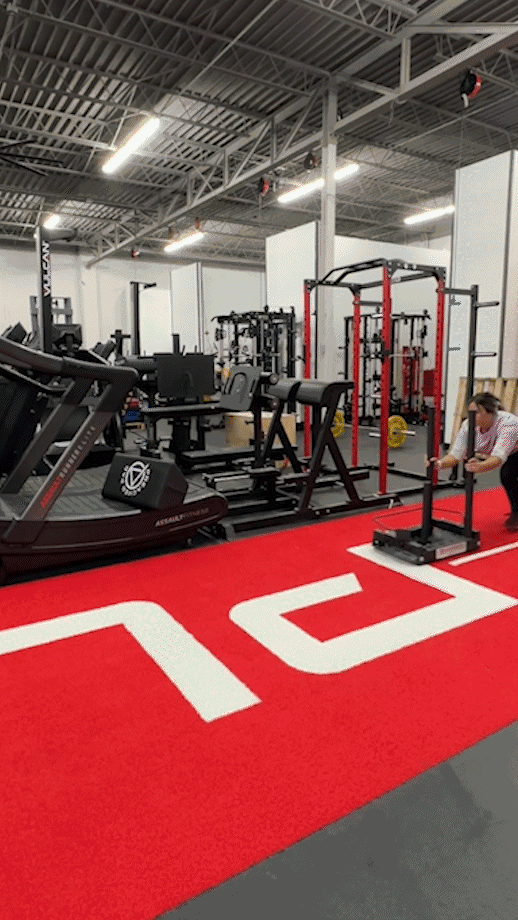
Trainer Tips for Form
The sled push exercise is a simple but challenging exercise to perform, and here are a few certified personal trainer (CPT) tips for you to get the best results from this fantastic exercise.
Decide Your Purpose
You can use the sled push to improve your power, speed, or endurance. Each requires different loadings and distances, so going in with an idea of what you want works better than just aimlessly going for it. For instance, if your goal is speed or endurance, a lighter load over a longer distance would suit you best, while a heavy load with a shorter distance would better suit strength training.
RELATED: How to Build Stamina for Running
Keep Your Head Up
The upper body plays a minor role but is vital with the sled push. Keep your spine neutral and head up to ensure proper lower body drive. It also helps to look up to know where you are going.
RELATED: Lower-Body Workouts
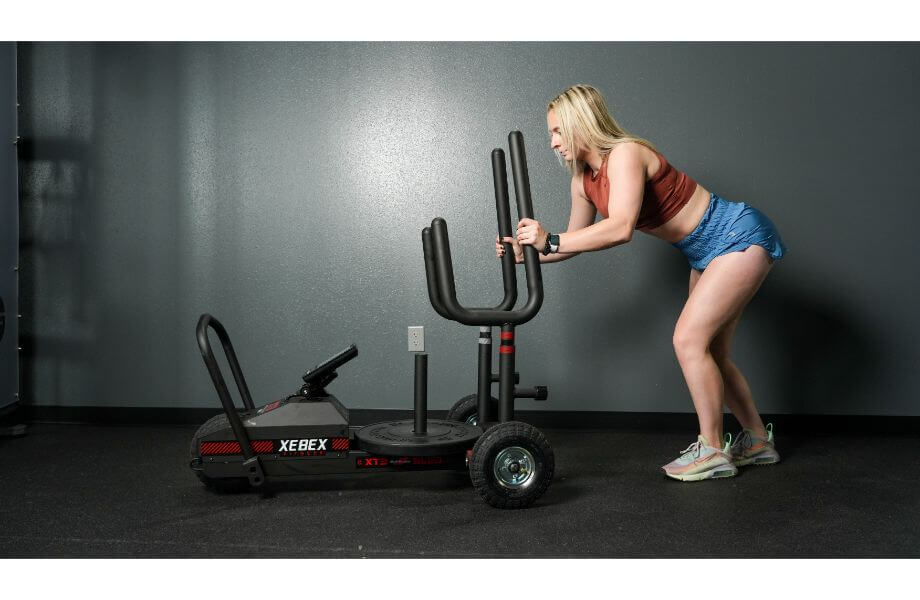
Don’t Be A Hero
The sled push workout is a taxing exercise for your legs and lungs, so get plenty of rest between reps for a better performance. Plus, you’ll hopefully avoid the prowler flu.
Sled Push Benefits
There’s got to be benefits of the sled push movement for as much as it hurts, right? Yes, and here they are.
Helps Improve Strength and Cardio
The sled push doesn’t just work your quads, glutes, and calves; it helps build up your endurance and lung capacity. The sled push is more of a hybrid (strength and cardio) exercise; it will improve your anaerobic fitness, conditioning, toughness, and full-body strength.
RELATED: Benefits of Cardio
Helps Increase Calorie Burn and Fat Loss
The sled push tests your anaerobic and aerobic system like never before. During your recovery, your body has to play catch up to get more oxygen—AKA excess post-exercise consumption (EPOC)1—which can result in an increase in calorie and fat burn.
Can Be Joint Friendly
The sled push is mainly driven by concentric muscle action, but what does that mean for you? It takes a little stress off the joints because of the lack of eccentric contraction on your hips, knees, and ankle joints. The sled push can be an excellent alternative to your regular quad exercises if lunges, squats, and deadlifts hurt your lower-body joints.
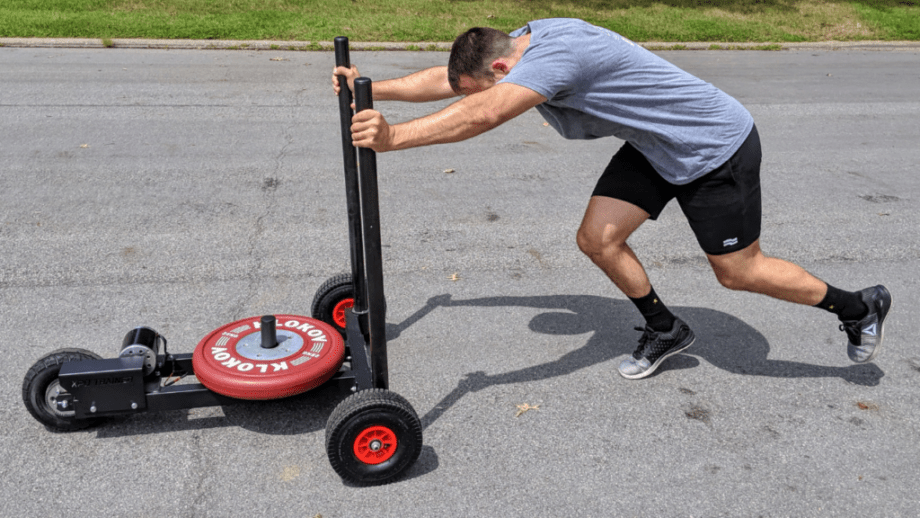
Common Sled Push Mistakes
The sled push is not a technical exercise like a barbell deadlift or squat, but that doesn’t mean mistakes can’t be made. Here are a few common hiccups that may stop you from getting the best from your sled push.
Rounded Back
It may seem easier to grab and go, but pushing or pulling a sled with a rounded back will not favor your spine. Instead, perform a hip hinge to get the upper body in the correct position and keep your head up and shoulders down.
RELATED: Hip Hinge Exercises
Improper Foot Strike
The sled push is predominantly a quad exercise with an assist from the glutes through hip extension. To ensure better lower body drive, strike the ground with the balls of your feet. Your heel should never touch the ground. If you find your heel touching the ground, focus on driving the knees higher and remaining on your tippy toes during the sled push.
Too Heavy
The sled push is not a one-rep max (1RM) strength exercise but one to improve your power, speed, and muscular endurance. Although those social media videos of heavy-load sled pushes seem cool, please remember the true purpose of the exercise and lighten the load. The contents of your stomach will thank you.
RELATED: Freak Athlete Multi Sled Review
Sled Push Variations
Like all great exercises, the sled push can be regressed and progressed. Below are a few of those movements and alternatives if you can’t access a sled.
Backward Sled Push/Sled Drag
Why do it: The sled push has you squat with your back against the sled to focus exclusively on your quadriceps and lungs.
How to do it:
- Load the sled with your desired weight.
- Get into a squat position with your back pushing into the sled poles.
- Push the sled forward by extending each leg one after the other.
- Repeat for the desired number of steps or distance.
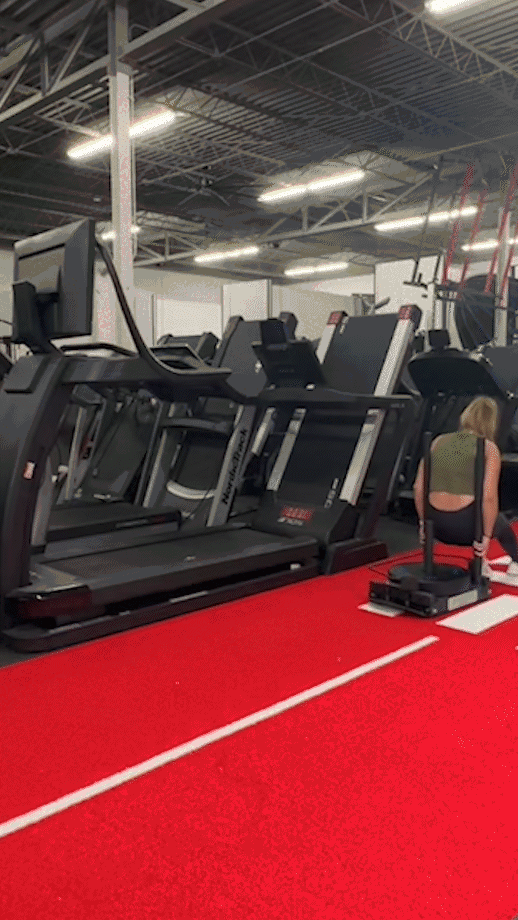
Plate Push
Why do it: The plate push is an effective exercise to simulate the actions of a sled when you don’t have access to one.
How to do it:
- Place a folded towel on a smooth surface and put a weight plate on the towel
- Hinge down to grip the weight plate and towel.
- On your toes, push the weight plate forward as fast as possible for distance or time.
Note: A kettlebell can be used here also.
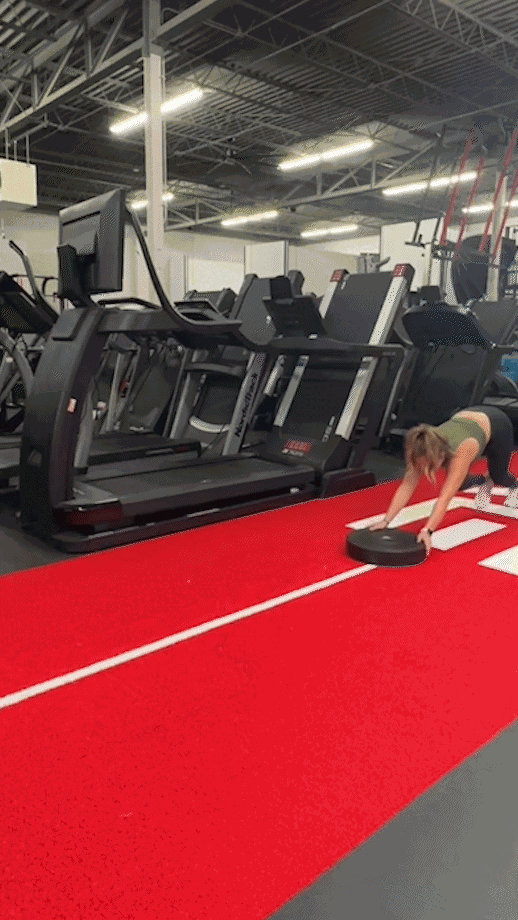
Treadmill Push
Why do it: Because you’re a sucker for punishment? Just kidding. The treadmill push uses the resistance of the stationary belt to simulate a sled push when you can’t access a sled.
How to do it:
- Step onto the stationary treadmill and put your upper body against the console.
- Flex your hip flexors and knees and drive your feet backward in the belt, like running on the spot.
- Run for your desired time and then rest and repeat.
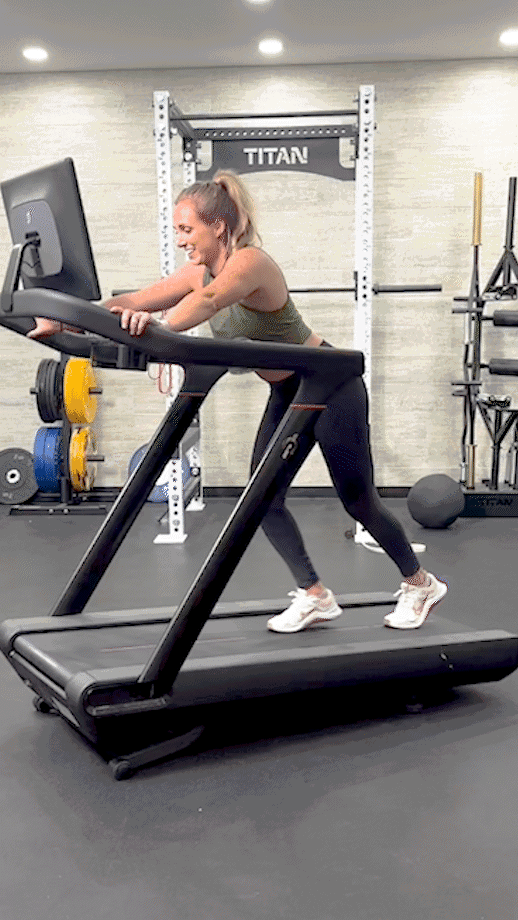
Farmer’s Walk
Why do it: The farmer’s walk is an alternative to the sled when you don’t have one focusing more on shoulder and grip strength than the sled push. The farmer’s walk is top-notch when you want to build strength in that area.
How to do it:
- Grip a pair of dumbbells from the rack with approximately 25% to 50% of your body weight on each hand.
- With your shoulders down, chest up, and grip tight, walk for your desired distance or time.
- Place the dumbbells back in the rack, rest, reset, and repeat for desired sets.
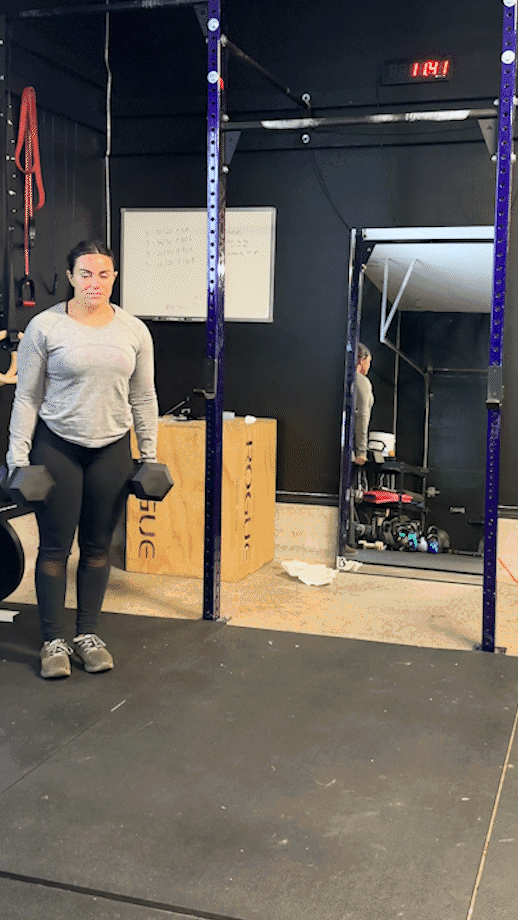
Sled Push Workout: FAQs
What muscles does the sled push work?
The sled push is a lower-body strength exercise using the muscle groups of the hamstrings, quads, glutes, and calves. The positioning of your elbows—extended or straight—will determine whether your triceps are being used.
What are the benefits of sled push exercise?
The sled push exercise is equal parts strength training and cardio, which helps strengthen your quads, glutes, and calves in a joint-friendly fashion. At the same time, it raises your heart rate to improve your anaerobic and aerobic cardiovascular fitness. You can also use the sled push as a cardio finisher in a CrossFit WOD and regress or progress it depending on your fitness level.
How much weight should I sled push?
How much weight you should push depends on your goals. If your goal is to build muscle, then a moderate to heavy sled is needed than if your goal is to improve your speed and power. You want moderate weight for muscle and light for speed training and power.
Do sled pushes burn fat?
The beauty of the sled push and sled training is the oxygen needed to recover after your rep. For every liter of O2 you breathe in, you burn five calories. The more intense you work out, the more oxygen you need, which helps burn fat.
References
- Schleppenbach LN, Ezer AB, Gronemus SA, Widenski KR, Braun SI, Janot JM. Speed- and Circuit-Based High-Intensity Interval Training on Recovery Oxygen Consumption. Int J Exerc Sci. 2017 Nov 1;10(7):942-953. PMID: 29170696; PMCID: PMC5685083.
Further reading

Post-workout recovery requires rest, hydration, and nutrition. This Kaged Re-Kaged review will help you decide if the protein powder could be a helpful contribution. Read more

When done properly, an efficient treadmill warmup can have your muscles primed and ready to work. Read more

What muscles does an elliptical work? Our team dives into the anatomy behind this popular low-impact workout. Read more

In this Do-Win Classic Lifter review, we point out how they perform well, but are they the most durable weightlifting shoe on the market. Read more

